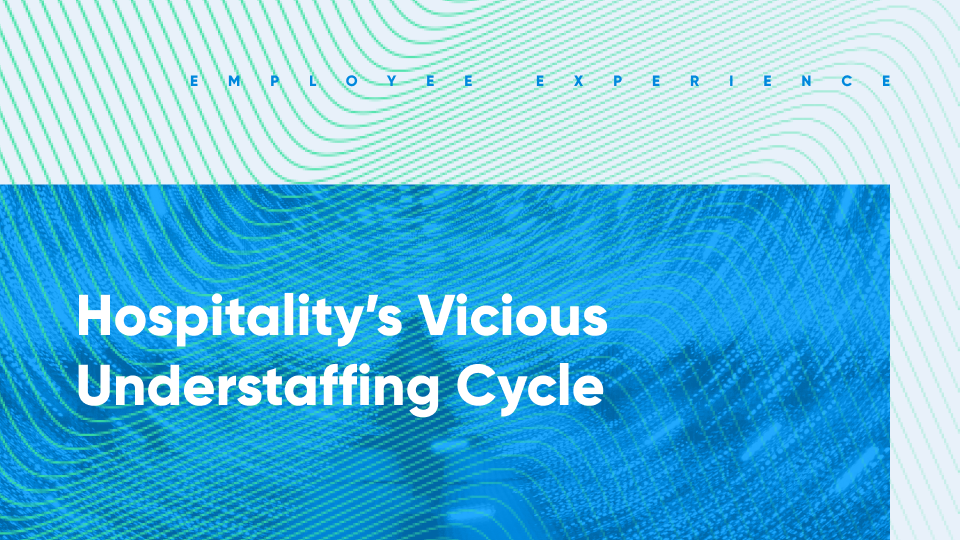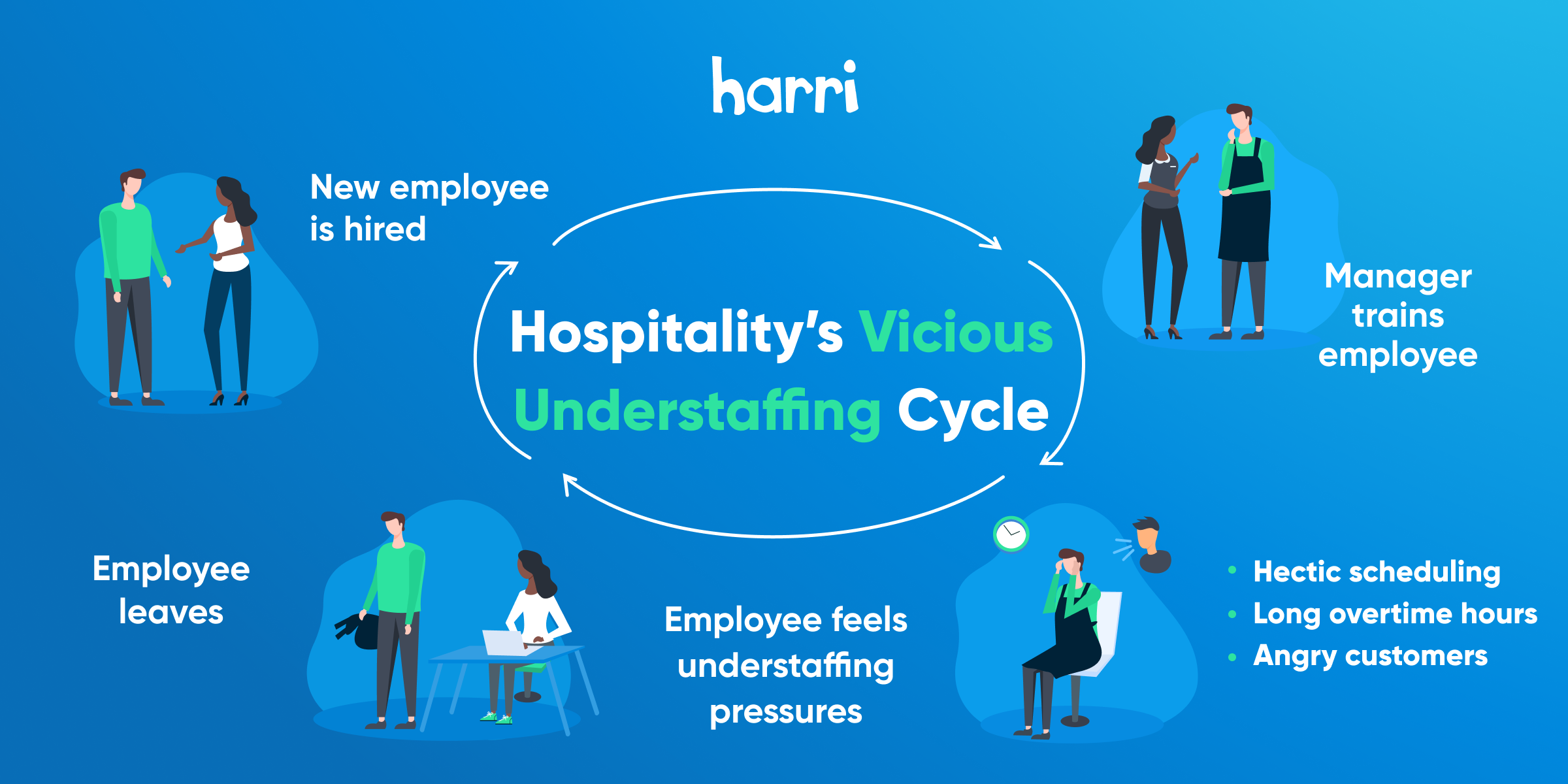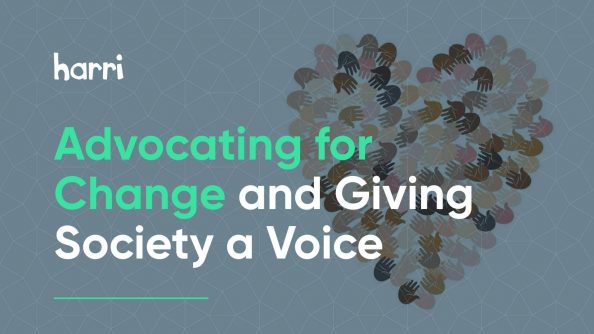Hospitality’s Vicious Understaffing Cycle

- By Harri Insider Team | November 13, 2021
Employment numbers and staffing strategies were completely disrupted by the pandemic. Across all industries, millions of people lost their jobs and livelihoods as regulations and shutdowns swept through the country.
It took us a year and a half to get into recovery mode, with the Department of Labor only recently issuing a report stating that unemployment is seeing a downward trend.
However, this does not apply to hospitality businesses. Why?
Well, the hospitality industry has always struggled to attract and retain talent due to a failure to address key employee experience factors that affect retention.
Frontline hospitality employees tend to follow this hiring pattern all within the first three months of employment:
- A brand posts a job ad to fill an open position
- A new employee is hired
- The new employee is trained by a manager
- The new employee feels understaffing pressures
- The employee leaves
- Back to step one
These understaffing pressures range from hectic scheduling and long overtime hours to the simple fact of dealing with angry customers…most of which are upset because a business is understaffed in the first place.
It’s a vicious cycle that will never be broken until we address staffing issues at their core.

Breaking the turnover cycle with smarter technology
In order to boost retention rates for new and existing employees, hospitality operators MUST invest time and effort into their employee experience, starting the moment someone sees their job ad.
However, anyone involved with end-to-end operational change knows that it can be a time-consuming and expensive process. Most managers are busy enough because of the labor shortage, they’re willing to forgo long-term success in order to tackle the challenges of today.
The right tools can simplify digital transformation without disrupting day-to-day operations, empowering operators to address critical employee experiences that impact hiring and retention metrics.
So, where should operators start?
An all-in-one HCM platform is the best option to improve end-to-end operational efficiency and remove internal fragmentation that might slow managers down.
After all, we spent so much time and energy over the past few years perfecting and digitizing the customer experience, isn’t it time we showed the employee experience the same level of care?
Let’s dive into the many ways an all-in-one HCM tool like Harri can help you attract and retain quality talent even in the face of a national understaffing shortage.
Scheduling has always been a major challenge not just within hospitality, but all service-driven industries.
From an employee experience perspective, flexible scheduling is key. In fact, our 2021 Employee Experience Survey asked 7,000 frontline workers what workplace factors matter most.
Can you guess the number one answer? “Having a reliable, predictable schedule.”
It’s not hard to see why – flexibility lets your employees know that you care about their lives, both inside and outside of work.
Our intelligent scheduling platform makes it easy to achieve scheduling flexibility without disrupting operations.
Position-based scheduling allows managers to better place employees in the most optimal shifts according to their growing skillset while also considering factors like availability and shift preferences. Overlay that against sales demand forecasting, and managers are better positioned to give team members the schedules they want while still catering to customer needs.
Our robust scheduling platform also gives team members autonomy to find shift times that work best for them while still fitting into your scheduling strategies. A true win/win scenario.
Enable automatic, direct, or pick-up shift functionality for employees so that they can trade and swap shifts on the go. Employers can define early, late, and unscheduled shift rules for employees so they can ensure that, while flexible, their employees are adhering to the set rules of the restaurant.
Built-in compliance is another, more subtle method to creating a positive employee experience. Laws related to breaks, such as meal breaks and unpaid 10-minute breaks, are built right into our scheduling platform.
We all know that hospitality is extremely fast-paced and that no schedule is truly set in stone. However, adding hours last-minute may make an employee eligible for one or more breaks. A manager might lose track of an employee’s hours during a particularly hectic day, and as a result, forget to formally schedule an employee’s break during the workday. Innocent mistake or not, this is a fast way to lose trust with frontline staff.
That’s why automated break management is so much more than just a labor compliance feature. It’s a way to ensure that all employees are given the breaks that they deserve while also providing two-way transparency into team schedules.
And because all scheduling information and shift swap tools are easily accessible from an intuitive mobile app, team members are empowered to take control of their schedules anywhere, anytime.
Engaging team communications
One of the most important lessons that the pandemic taught is that consistent, effective communication is essential to the success of any hospitality business. Top-down, bottom-up, or horizontal. No matter how you look at it, employees want to feel connected.
To bring the conversation back to our 2021 Employee Experience Report, frontline hospitality workers named “feeling part of the team” as the third most important piece of the employee experience, further emphasizing the need for strong communications systems.
Our intuitive communications platform allows employers to create and invite team members to group message channels to relay important pieces of information. Groups can be organized by role, responsibility, location, or unit in an effort to target the right team members, and new hires are automatically added or moved to group chats based on their position.
Why Is that important? Well, there’s a few reasons.
If you continuously throw messages intended for back-of-house staff into a general group chat, your front-of-house staff might be less inclined to actually read those messages. When the time comes that you send out a not critical to those front-of-house employees, they might miss the message entirely. In short, segmentation improves clarity.
Ensuring messages are received by the right people provides benefits like:
- Provide team members with the information they need to succeed at their job
- Improve retention by fostering a family-like environment
Social media-style newsfeeds found within our communications platform further emphasize communication as a tool to celebrate the success of your frontline staff. Give frontline staff an outlet to share images of work events, highlight wins to the entire team, and contribute to the culture that you’re cultivating.
Big changes are coming to our communications platform at the enterprise level. Stay tuned for more information on how we plan to further empower hospitality teams to achieve unparalleled levels of connectivity throughout their organization.
Late clock-ins are a key metric associated with frontline turnover. Increasing instances of late clock-ins can indicate dissatisfaction with an employee’s job or with your brand as a whole.
The ability to identify these patterns and then act accordingly is key.
Whether the employee is genuinely losing interest, or if they had scheduling needs that changed, a simple check-in could remedy the issue before an employee moves onto a new opportunity.
Our time and attendance tools alert managers when these patterns start to emerge, empowering them to identify signs of early-stage turnover. Whether you’re overseeing ten, one hundred, or one thousand, teams can get a pulse on organization-wide clock-in rates and how they impact retention metrics.
Also embedded within our time and attendance tools are shift feedback surveys, an excellent tool to gauge team morale.
When clocking out for the day, employees will be asked to rate their shift by selecting a happy face or a frowny face icon.
Noticing several frowny faces from a particular employee? Time to check and see how you can assist.
This is more than just a tactical way to improve team satisfaction. As the saying goes, people quit managers, not jobs. Shift feedback surveys make it easier for managers to be that pillar of support that frontline employees are looking for. That level of trust can go a long way.
Finally, let’s talk about compensation — a critical factor to the employee experience.
Because our timeclock integrates directly with your preferred payroll provider, employees are guaranteed to receive the correct payment no matter the circumstances. Picture last-minute shift extensions which then roll into overtime or even premium payments related to Fair Workweek. Maybe an employee opted to skip a meal break to lend a hand during a busy shift, entitling them to additional pay hours.
In these scenarios, you always want to make sure your team is properly compensated, else you risk more than just turnover — you risk hefty non-compliance fees on top of employee dissatisfaction.
This fully integrated system ensures correct payment without requiring managers to become compliance experts or reconcile each and every schedule, though they do have the option to amend timesheets before payday if needed.
Moving forward with retention-driving technology
Tackling the wide range of employee experience-related challenges might seem overwhelming, but the right solution can ensure a successful strategy, one operational process at a time. From multi-unit QSRs to massively staffed fine dining restaurants, there are plenty of ways to optimize the employee experience and improve retention.
Learn how an end-to-end employee experience platform like Harri can provide you with the tools to reduce turnover as you and your team navigate uncertain times.




















